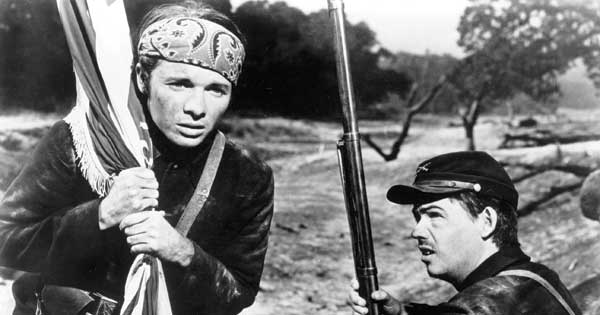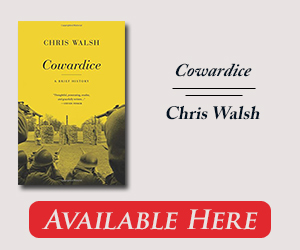
Cowardice: A Brief History, by Chris Walsh, Princeton University Press, 292 pp., $27.95
Cowardice. The word itself is explosive. It may be the worst quality you can associate with a man in wartime, and as Chris Walsh, a professor of writing at Boston University, demonstrates in his new book, it has inspired surprising violence by individuals and nations alike. We take note when someone can stand up to such taunts, as when Woodrow Wilson famously said he would not be rushed into war even “if every damned congressman and senator gets up on his hind legs and calls me a coward.” By contrast, once we were in the war, enlistment posters warned the potential coward that someday a pretty daughter would be on his knee asking, “Daddy, what did YOU do in the Great War?”
Cowardice in battle brings inner shame and public infamy. The Civil War sailor Marion Stevens suffered from “deep mortification,” according to the Richmond Daily Dispatch, when he was busted from lieutenant to private on a charge of cowardice. He shot himself, survived, and then shot himself again and died. In England during World War I, 16-year-old Herbert Burden lied about his age to join the army, but once in, found it a bad fit. When a friend’s brother was killed, Burden left his regiment to console him. When he was apprehended, his commanding officer reported that he was of “inferior physique” and “addicted to absence,” and in 1915, still too young to legally serve, he was found guilty of cowardice and executed. A sculpture of Burden is at the center of the Shot at Dawn Memorial in Alrewas, England, which honors soldiers executed for desertion. Burden is depicted, Walsh writes, “not [as] a coward but a victim, a boy done in by insidious, powerful forces that duped him into war and then punished him for being human.” The memorial is evidence of how opinions change over time, but even at any given moment, the consequences of cowardice have proved unpredictable. Sometimes, for instance, so many men desert that all or most of them go unpunished.
Walsh focuses on Stephen Crane’s The Red Badge of Courage, about the experience of having been cowardly in one’s own estimation. Private Henry Fleming had “conceived persons with torn bodies to be peculiarly happy. He wished that he too had a red badge of courage.” But when the time comes to fight, Henry runs away in terror. At a safe distance, he is overwhelmed with shame, self-hatred, and fear, and he prepares himself for life as a pariah. Later, he realizes that no one saw him run or noticed that he was gone; indeed, few soldiers knew much about what anyone did in the chaos, and because of this, Henry absolves himself of guilt.
So cowardice is a fragile concept, needing witnesses to make it real, and it gets more fragile the closer we look. When a man spontaneously refuses combat, is it more or less shameful if he does so because he suddenly can’t move his legs, or because he takes off uncontrollably toward the rear? How about if he sees a friend die and makes a reasoned decision to walk off the field? It seems wrong to blame a man for what may simply be his nature, but in some cultures, or subcultures, this is just the point: war is the great trial that sorts the truly courageous men from the braggarts and fakes, and combat is the moment of truth. But it is worth asking, if the penalty for cowardice is death, what is cowardice afraid of? It has always been possible to recognize that intention and action are not separated by mere will. Lincoln is supposed to have asked for leniency for some deserters by quipping, “[N]o doubt many a pair of cowardly legs has run away with a valiant heart.”
 As Walsh notes, most of us are not soldiers in battle, so for us cowardice is about not daring to live full lives. His consideration of the cowardice that stops us from trying or persevering is interesting, but it is odd that he does not here, at least, turn to the experience of women. As Thoreau wrote, “Whatever your sex or position, life is a battle in which you are to show your pluck, and woe be to the coward.” Literal battlefield cowardice, historically male, depends on the possibility of running away. But women have needed courage for experiences from which it is impossible to run away—the next contraction, for instance, or sexism. It would be great to see a study of how women view cowardice and how others have applied the term to women, in fiction, memoir, political speech, film, and journalism. Especially because cowardice is such a gendered idea, some clarifying ideas might emerge. It is not cowardly, for example, if you walk into a situation with the intention to fight, and once there reassess and change your mind. So cowardice is a matter of existing within a belief system, but failing it. Beyond duty to country, people fail at their own ideals of familial devotion, creative inspiration, spiritual calling, or self-defense, and call it cowardice. Bringing women into the study of the word would have given us this bigger picture. But again, if we take Walsh’s book as a treatment of cowardice of men in battle, it is an entertaining and insightful guide to a heart-pounding subject.
As Walsh notes, most of us are not soldiers in battle, so for us cowardice is about not daring to live full lives. His consideration of the cowardice that stops us from trying or persevering is interesting, but it is odd that he does not here, at least, turn to the experience of women. As Thoreau wrote, “Whatever your sex or position, life is a battle in which you are to show your pluck, and woe be to the coward.” Literal battlefield cowardice, historically male, depends on the possibility of running away. But women have needed courage for experiences from which it is impossible to run away—the next contraction, for instance, or sexism. It would be great to see a study of how women view cowardice and how others have applied the term to women, in fiction, memoir, political speech, film, and journalism. Especially because cowardice is such a gendered idea, some clarifying ideas might emerge. It is not cowardly, for example, if you walk into a situation with the intention to fight, and once there reassess and change your mind. So cowardice is a matter of existing within a belief system, but failing it. Beyond duty to country, people fail at their own ideals of familial devotion, creative inspiration, spiritual calling, or self-defense, and call it cowardice. Bringing women into the study of the word would have given us this bigger picture. But again, if we take Walsh’s book as a treatment of cowardice of men in battle, it is an entertaining and insightful guide to a heart-pounding subject.

